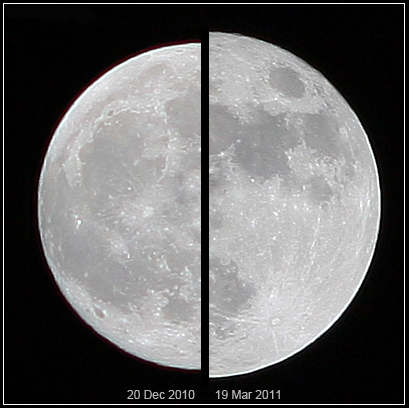A Super Blue Moon
Come on, get ready. In a few hours, not only will you be seeing a Blue Moon, but it'll also be a Supermoon. Together, there'll be a Super Blue Moon.
Blue moons are okay. At the very least, they are the second full moon in a calendar month. But what's a supermoon?
Simple. The Moon's orbit around Earth is not a perfect circle. It's elliptical. By the nature of elliptical orbits, the Earth-Moon distance doesn't remain constant everywhere. If orbits were perfect circles, the Earth-Moon distance would've yielded some constant figure. Instead, in an elliptical orbit, the Moon moves through two extreme positions - perigee and apogee. Perigee refers to the farthest point in its orbit where the Moon can be from Earth, and apogee means the closest point. Anywhere else in the orbit, the Moon's distance from Earth stays somewhat close to 384,400 km. At perigee, the Moon comes as close as 356,400 to 370,400 km, an average of 362,600 km from Earth. On the other hand, at apogee, the Moon can lie between 404,000 to 406,700 km away from Earth, an average of 405,400 km. The apogee/perigee distance varies because of gravitational perturbations (just some minor push and pull) from the Sun.
When the Moon comes full-phase close to perigee, we call it a Supermoon. Super in the sense that anywhere within 90% of perigee, a full Moon appears 7% larger and 15% brighter than usual. Don't get your hopes high yet. A 7% increase in size is imperceptible unless you're an acute observer. Nonetheless, comparing photographs of an ordinary full moon and a supermoon, you can easily spot the difference. Here's a picture from Wikipedia.
 |
| On the left we have a normal full moon and on the right a supermoon or a super full moon. Image Credits: Public Domain, via Wikimedia Commons. |
If you head out to observe the Moon immediately after sundown, the Moon may appear eerily big as it hangs low over the horizon. This is the famous Moon Illusion - a funny trick our brains play with us. Looking at the Moon, while it's low on the horizon, our brains fail to judge how far the Moon actually is with respect to the foreground objects, buildings, and trees. Failing to perceive the actual distance, our brains wrongly assumes the Moon to be very far. Not knowing know far though, the brain conceived the Moon to be very big. It's illusory because no matter where the Moon is in the sky, it always subtends the same angle - half a degree across the celestial dome - except when the Moon moves through its apogee and perigee points in its orbit.
Just as the Moon subtends a greater apparent diameter close to perigee, an apogean full moon appears 7% smaller and 15% less bright than an ordinary full moon. Popularized as Micromoon(s), the slightly smaller apogean full moon also escapes our notice.
 |
| Relative size comparison of a supermoon and a mircromoon. Image Credits: NASA/JPL-Caltech, Public Domain, via Wikimedia Commons. |
This August, we got the chance to see all three lunar phenomena. For 12 full moons in a calendar year, there's a separate name for each of them. August's full Moon is called a Sturgeon Moon, named of course, after the sturgeon fish found in the Great Lakes of North America. We had all witnessed the Sturgeon Moon on 1st August. And now, it's time to for a rare Super Blue Moon.
Supermoons typically occur 3 - 4 months apart, Blue Moons happen every 2.5 years, and a Super Blue Moon may occur once every 10 years. Anyway, let's wish for a good night.


Comments
Post a Comment